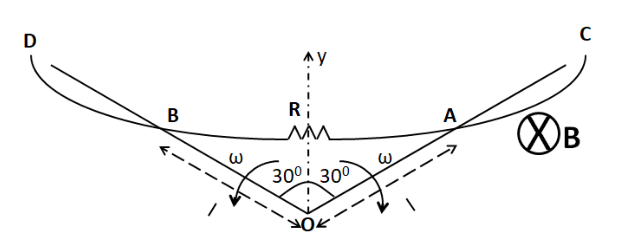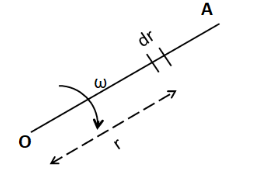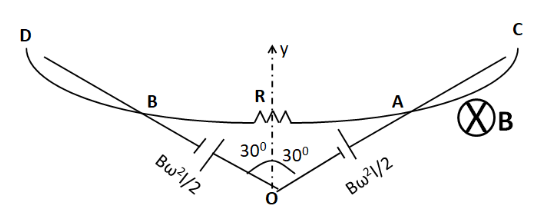Question
Question: In the figure, there exists a uniform magnetic field \( B \) into the plane of paper. Wire \( CD \) ...
In the figure, there exists a uniform magnetic field B into the plane of paper. Wire CD is in the shape of an arc and is fixed. OA and OB are the wires rotating with angular velocity ω as shown in the figure in the same plane as that of the arc about point O . If at some instant, OA=OB=l and each wire makes angle θ=6=30∘ with y-axis, then the current through resistance R is (wire OA and OB have no resistance)

(A) 0
(B) RBωl2
(C) 2RBωl2
(D) 4RBωl2
Solution
To solve this question, we have to find out the emf generated in each of the two rods using the motional emf equation. Then, we need to calculate the potential difference across the resistor and hence the current using Ohm’s law.
Formula used: The formulae which are used to solve this question are given by
e=Blv , here e is the emf induced in a rod of length l which is moving with a speed of v in a direction perpendicular to its length in a region of magnetic field B perpendicular to its plane.
F=q(v×B) , here F is the force acting on a charge q which is moving with a velocity v in a magnetic field of B .
Complete step by step solution:
We need to first consider the motion of rod OA. As it moves in the uniform magnetic field which is present into the plane of paper, the Lorentz force acts on each of its free electrons, due to which an emf is generated across its length.
Consider a small element of length dr on the rod OA, at a distance of r from the point O, as shown below.

The velocity of this element is
⇒v=ωr ………………..(1)
As the rod is moving perpendicular to its length in a magnetic field which is perpendicular to the plane of the rod, so the emf generated across the element is given by
⇒de=Bvdr
From (1)
⇒de=Bωrdr
For the total emf generated across the whole length of the rod, we integrate the above equation
⇒0∫ede=0∫lBωrdr
As the magnetic field and the angular velocity are constant, so we have
⇒0∫ede=Bω0∫lrdr
⇒[e]0e=Bω[2r2]0l
On substituting the limits, we get
⇒e=2Bωl2
From the Lorentz force equation, we have
⇒F=q(v×B)
For an electron, q=−e . So we have
⇒F=−e(v×B)
From the right hand rule, we get the direction of the force on each electron towards the end O of the rod. Hence, the end O of the rod is at a lower potential with respect to the end A, by the amount 2Bωl2 .
Similarly, we can show that the end O of the rod OB is at a higher potential than the end B by the same amount. Thus we can replace both the rods OA and OB by the two batteries as shown below.

From the above figure, we can see that
⇒Vo−VB=2Bωl2 ……………….(2)
Also
⇒VA−Vo=2Bωl2 ………………….(3)
Adding (2) and (3), we get
⇒Vo−VB+VA−Vo=2Bωl2+2Bωl2
On simplifying, we get
⇒VA−VB=Bωl2
⇒VAB=Bωl2 ………………..(4)
We can see from the above figure that this is the potential across the resistance R . So the current through the resistance can be given by
⇒I=RVAB
From (4)
⇒I=RBωl2
Thus the current through the resistance is equal to RBωl2 .
Hence the correct answer is option (B).
Note:
We must note that in this question, the values of the angles made by the wires with the y-axis given are useless. They are just given to deviate us from the correct approach. We don’t try to find out the area of the triangle from the value of these angles, as no triangle is formed in the figure. This is because the wire AB is not straight but is in the form of an arc.
